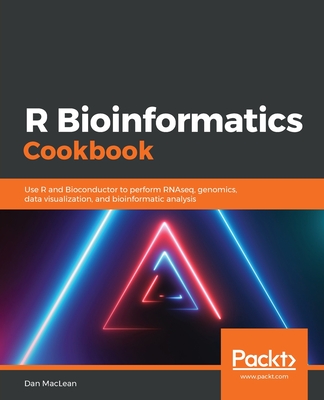Bioinformatics with Python Cookbook - Second Edition
暫譯: Python 生物資訊食譜 - 第二版
Tiago Antao
- 出版商: Packt Publishing
- 出版日期: 2018-11-30
- 定價: $1,580
- 售價: 6.0 折 $948
- 語言: 英文
- 頁數: 360
- 裝訂: Paperback
- ISBN: 1789344697
- ISBN-13: 9781789344691
-
相關分類:
Python、程式語言、生物資訊 Bioinformatics
-
其他版本:
Bioinformatics with Python Cookbook, 3/e (Paperback)
買這商品的人也買了...
-
 $980Principles of Multimedia Database Systems (Hardcover)
$980Principles of Multimedia Database Systems (Hardcover) -
 Bioinformatics Algorithms: Design and Implementation in Python(美國原版)
Bioinformatics Algorithms: Design and Implementation in Python(美國原版)$4,150$3,943 -
 別說你不懂理財!善用 Python 幫助你投資獲利,改善財務
別說你不懂理財!善用 Python 幫助你投資獲利,改善財務$350$277 -
 Python 最強入門邁向數據科學之路 -- 王者歸來 (火力加強版)
Python 最強入門邁向數據科學之路 -- 王者歸來 (火力加強版)$799$527 -
 Introducing Python: Modern Computing in Simple Packages, 2/e (Paperback)
Introducing Python: Modern Computing in Simple Packages, 2/e (Paperback)$2,080$1,976 -
 R Bioinformatics Cookbook
R Bioinformatics Cookbook$2,000$1,900 -
 Mathematics for Machine Learning (Paperback)
Mathematics for Machine Learning (Paperback)$1,480$1,450 -
 $658R語言數據可視化:科技圖表繪制
$658R語言數據可視化:科技圖表繪制
商品描述
Discover modern, next-generation sequencing libraries from Python ecosystem to analyze large amounts of biological data
Key Features
- Perform complex bioinformatics analysis using the most important Python libraries and applications
- Implement next-generation sequencing, metagenomics, automating analyses, population genetics and more
- Explore and analyze bioinformatics data using standard statistics and Machine Learning approach
Book Description
With increasing biological data, there's a need for bioinformaticians in order to analyze them and extract insights. This book uses a unique recipe based approach to address the key building blocks in bioinformatics domain using Python ecosystem.
This book is packed with all the emerging topics ranging from Metagenomics, Transcription of DNA to RNA, Bioinformatics shell scripting, Web interaction, Automating analyses and more. You will get to work with different set of data such as sequence data, alignment data, range data, genome data and more for analyzing a large amount of biological data. You will get a better understanding of working with Galaxy server, which are the widely used bioinformatics web-interfaces. This book will also show you GPU computing for computationally complex problems via OpenCL and PyOpenCL. This second edition will also cover Machine Learning techniques in Bioinformatics. You will explore topics like SNP discovery using SVMs and exploratory analysis of data using standard statistic and ML approaches.
By the end of this book, you will be able to implement modern programming techniques and frameworks to deal with the ever-increasing deluge of bioinformatics data.
What you will learn
- Learn how to process large next-generation sequencing (NGS) datasets
- Work with genomic dataset using FASTQ, BAM and VCF formats from Python interface
- Explore the steps to perform sequence comparison and phylogenetic reconstruction
- Perform geometric operations with atom and molecule data
- Discover vilsualization techniques inside a galaxy server
- Learn GPU computing for computationally complex problems via OpenCL and PyOpenCL
- Visualise protein dataset interactions using Cytoscape
- Understand the steps involved in training an SVM for SNP discovery
Who This Book Is For
This book is for Data Scientists, Bioinformatics analysts, researchers, and Python developers who want to address intermediate-to-advanced common biological and bioinformatics problems with the recipe-based approach. Working knowledge of Python programming language is expected.
商品描述(中文翻譯)
**探索來自 Python 生態系統的現代次世代測序資料庫,以分析大量生物數據**
#### 主要特點
- 使用最重要的 Python 函式庫和應用程式執行複雜的生物資訊學分析
- 實現次世代測序、環境基因組學、自動化分析、族群遺傳學等
- 使用標準統計和機器學習方法探索和分析生物資訊學數據
#### 書籍描述
隨著生物數據的增加,生物資訊學家對於分析這些數據並提取見解的需求日益增加。本書採用獨特的食譜式方法,針對生物資訊學領域的關鍵構建塊進行探討,並使用 Python 生態系統。
本書涵蓋了從環境基因組學、DNA 轉錄為 RNA、生物資訊學 shell 腳本、網頁互動、自動化分析等所有新興主題。您將處理不同類型的數據,如序列數據、比對數據、範圍數據、基因組數據等,以分析大量的生物數據。您將更好地理解如何使用 Galaxy 伺服器,這是廣泛使用的生物資訊學網頁介面。本書還將展示如何通過 OpenCL 和 PyOpenCL 進行計算複雜問題的 GPU 計算。本書的第二版還將涵蓋生物資訊學中的機器學習技術。您將探索使用 SVM 進行 SNP 發現和使用標準統計及機器學習方法進行數據探索性分析的主題。
在本書結束時,您將能夠實現現代編程技術和框架,以應對不斷增加的生物資訊學數據洪流。
#### 您將學到什麼
- 學習如何處理大型次世代測序 (NGS) 數據集
- 使用 Python 介面處理 FASTQ、BAM 和 VCF 格式的基因組數據集
- 探索執行序列比較和系統發育重建的步驟
- 使用原子和分子數據執行幾何運算
- 發現 Galaxy 伺服器內的可視化技術
- 通過 OpenCL 和 PyOpenCL 學習 GPU 計算以解決計算複雜的問題
- 使用 Cytoscape 可視化蛋白質數據集的互動
- 理解訓練 SVM 以進行 SNP 發現的步驟
#### 本書適合誰
本書適合數據科學家、生物資訊學分析師、研究人員和希望以食譜式方法解決中級至高級常見生物和生物資訊學問題的 Python 開發者。預期具備 Python 編程語言的工作知識。









